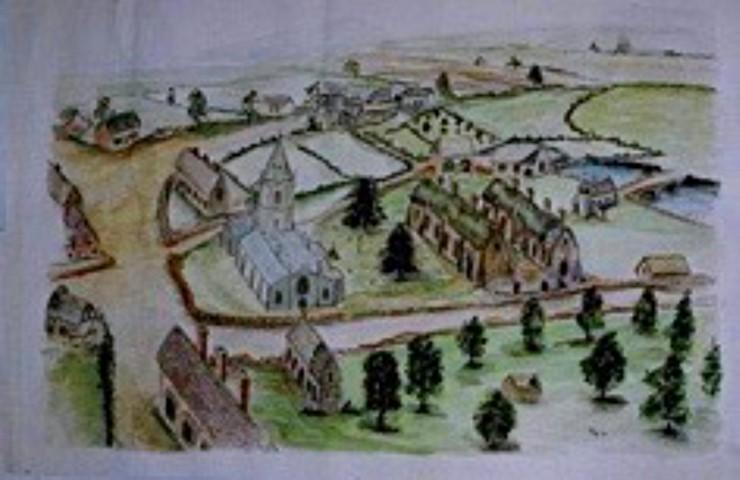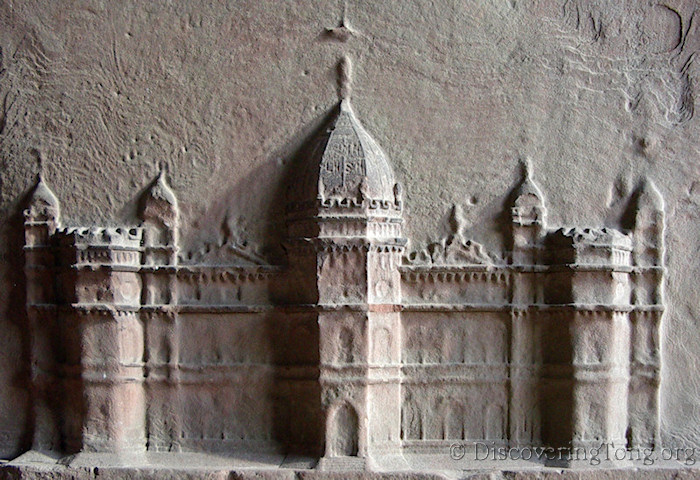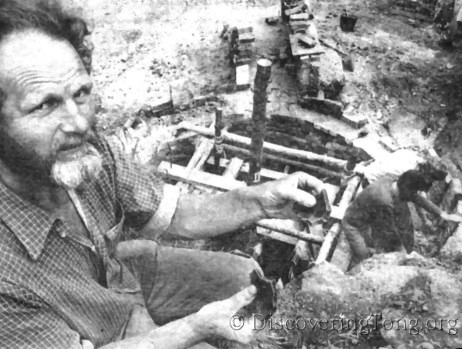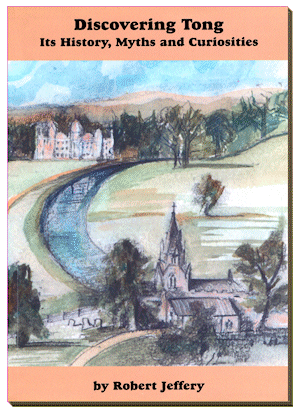
St Bartholomew’s, Tong
Discovering Tong
Castle Excavation
Tong Castle Excavation
In tribute to Alan Wharton, this page describes some of the archaeological excavations he carried out at Tong (1975-1986). It is written by Robert Stallard who helped initiate and carry out the excavation. The information here is not included in the ‘Discovering Tong’ book.

Background
When the new town of Telford was built it needed a Motorway link to attract new businesses to it. Telford was one of the last new towns to be built in the U.K., it was intended to regenerate the run down areas between Ironbridge and Wellington. This whole area had grown up after the Industrial Revolution ➚ had started at Ironbridge, it became a ramshackle sprawl of open cast and deep coal mines, small scale ironworks and light industry. When coal mining became uneconomic the area fell in to decay with high unemployment. At the same time the prospect of a new town offered the allure of new housing for those in the poorer districts of Birmingham and the Black Country only thirty miles away. Potential employers required a good link to the road network to tempt them into relocating to a town tucked away in the heart of ‘rural’ Shropshire. So the Telford Development Council issued plans for a Motorway link from Telford to the M6.
Routes and Inquiries
There were three proposed routes for the new M54 road ➚ all with their various pros and cons. The favoured route came through Tong and right across the site of Tong Castle. Public meetings led to appeals and the setting up of a lengthy public inquiry. The result was that the inquiry favoured finding an alternative route. To the dismay of the Tong villagers the findings of the inquiry were summarily over-turned by the Minister. To this day many people believe that the results of a public inquiry have some clout, not so, a minister can ignore them and is not obliged to give reasons. So the M54 was to come through Tong no matter what the local people thought about it.

Tong Castle Site
The archaeological report for the Tong route was either negligent or even worse connived with the planners by reckoning there was nothing of value on the Tong Castle site. It reported that if there were any buildings prior to the Durant building they were probably small and completely destroyed when creating the Tudor castle or the Durant 1765 building. In the 1890s George Griffiths had produced a History of Tong and Boscobel ➚ which seemed to show that the Tong Castle site dates back hundreds of years. The book is not a wholly accurate historical document, as can be guessed by the first Chapter that links Tong with Merlin ➚ and the time of King Arthur [If there was any link it might have been with Tong in Kent ➚]. Griffiths was tapping into the resurgent Victorian interest into all things Arthurian.
There is very little documentary evidence for an old castle, this can be mainly explained by the many changes of ownership over the centuries with ample opportunities to ‘lose’ documents. There was a fire at the Pierrepont library at Thoresby ➚ in 1745 that probably destroyed a great many Tong documents.
So the main piece of evidence of a substantial castle prior to 1765 was based on the Buck engraving of Tong Castle in Shropshire. This evidence could not be disputed but some experts even put the site of this castle at Tong Norton ➚ where it would not have been disturbed by the motorway.
Alan Wharton comes to Tong
The Midland Road Construction Unit (MCRU) who controlled the M54 construction had no plans to excavate the Castle site and the date of the Motorway construction loomed ever closer. One villager in Tong tried to find out what was happening about the site and by good fortune Alan Wharton, then working at Rowley’s Mansion museum at Shrewsbury became involved with the project.
Bizarrely, an initial concern was the rescue of the Durant ‘Gazebo’ (an ornamental roadside pulpit) in the grounds of Convent Lodge rather than the castle itself.
After a letter in the Shropshire Star ➚ newspaper, mounting public pressure resulted in acceptance of a plan for small scale rescue archaeological work and a short delay to the construction plans. The castle site is part of the Bradford Estate and the excavation was carried out with the kind permission and interest of the landowner – the Earl of Bradford ➚. The principal aim was to confirm that the plan of the Castle shown in the Buck Engraving (about 1731) bore some relation to the structures in the ground. The season started in the long, hot summer of 1976 ➚. All the excavations were carried out by volunteers. Alan had to beg for little bits of funding from many sources : Local landowners, the Walker Trust, Ancient Monuments and local villagers. Alan lived in very limited accommodation, initially in a caravan and the archaeological finds were stored in a disused hen house.

Alan’s news for 28 January 1976
“My provisional programme is a Survey and investigation at the base of the north wall during April, surface excavation on the top of the original North-West Tower during the Spring Holiday and excavation to determine the build and possible moat to the East of the Tower in July and August.”
The initial plan for the summer more than met Alan’s expectations, wherever they dug they found more structures that needed more trenches to work out the inter-relationship and age. Evidence showed that there was a massive ditch across the north-east side, making the site highly defensible – the other sides are hemmed in by steep sided valleys. The ditch was strong evidence for a substantial, early mediaeval castle. Indeed when investigating the east-most area of the site a storage pit was uncovered with undoubtedly early content.
Initial trenches were uncovering finds from as early as the 12th century and so at least 800 years of occupation on the castle site. Many archaeologists tend to avoid these types of excavations because it is so difficult to work out in which order buildings were made and modified; they much prefer to tackle a site that was occupied for a short time as it gives a clear snapshot of life at one time rather than a blurred and incomplete picture of a site under continual change. The castle at Tong was altered and rebuilt several times. For example, there was fortification in response to the Peasant’s revolt of the fourteenth century and a rebuild after damage in the Civil War ➚.
Most significantly was the creation of a brick mansion at the time of Henry Vernon c.1515. Bricks were found everywhere in all shapes and sizes. A brick building hardly seems a remarkable thing to find, but at the time it was built, a brick mansion was in this part of the UK an innovation and the most fashionable type of building material that only the richest people could afford.
Alan held an exhibition of the finds in Tong village hall in October 1976 showing clear evidence of occupation back to the12th century and a very impressive range of pottery, bones and clay pipes.
All the work began at the front (north-east) part of the site; the rear of the promontory (south-west end) was not considered a target area. However it was in this area that much of the early history took place. The later ‘mansion’ houses at the front of the site had left these earlier structures undisturbed as ruins in the rear garden.
Over the next few years Alan’s excavations identified plans for nine distinct ‘builds’ of castle on the same site from the 11th century through to the final Durant mansion of 1765. It was an excavation with many exciting discoveries as so little was known about the castle beforehand.
The Well
Finding a mediaeval well was one of the main highlights of the dig. A well is important for two reasons the material naturally forms sealed ‘datable’ levels (stratified) the earliest at the bottom and also the material is often well preserved due to permanent presence of moisture.
Alan’s news for 23rd October 1976
“…I saw a depression in the ground, in from the wall and cut a circle in it and told Don that if he dug he would find a well. Lo and behold we now have 2 courses of a oval shaped red sandstone well…”
Excavating a deep, narrow well poses a great many problems and it took a lot of ingenuity and not to say hard physical effort to clear it out – all 12.5m (40ft) of it. One problem was getting down into it, a conventional ladder did not fit the bill so a purpose built ladder made from neighbouring trees was constructed and permanently lashed into the Well.
Over the next eighteen months a great many important finds came out of it, including a leather shoe, candle holder, double-sided comb, well bucket and chain, various keys, a gilt-bronze ewer and a gold ring.
Another of the exciting discoveries on the site was an underground chamber, which was very finely built. It had rib fan vaulted ceiling made with individually crafted bricks and dated from the Henry Vernon‘s castle of the early 16th century. The chamber was located on the South wall some way from the mansion/castle and was obviously built to be concealed from view. A trackway from the castle meant that should it come under attack; the family could escape to the chamber undetected. It was in use during the Civil War and was then repaired shortly afterwards.

The Ice House
The Georgian Durant mansion came with one of the latest innovations – an Ice House ➚. Providing blocks of ice for cold storage of meat and vegetables greatly enhanced the variety of food available for the castle’s inhabitants, as well as providing ice cubes. The system relied on collecting and cutting ice in the winter months from the nearby Church Pool and storing it in a large, well-insulated construction. The existence and location of the 1765 ice-house had been known for many years. It is a large barrel shaped brick structure 12m x 5m buried underground. A complete, early example of such an ice-house is extremely rare, and the Avoncroft Museum of Buildings ➚ at Stourbridge decided to rescue the structure. So the ice-house at Tong was taken apart brick by brick, transported to Avoncroft and re-built. A full report was produced describing the ice-house in great detail.
After the Castle the College
After many delays the Motorway that was due to be built in 1976/1977 actually was bulldozed through in 1982. Alan had to fight long and hard to get the castle dig completed satisfactorily. The construction team feared that any additional archaeological work might lead to considerable delay and expenditure if more structures were found.
The saving grace of the whole project was that it was decided that to save money the motorway was reduced from six lanes to four lanes. Reducing the width of the required cut for the road through the castle site resulted in the preserving of some of the castle remains. Particularly gratifying is that the earliest remains on the SW tip of the promontory were saved and can now be seen as you drive along the Motorway.
Alan then moved on to investigate the site of Tong College. There was known to be a college close to the church founded in 1410 at the same time. The site had been sketched in 1911 when a dry summer left outlines of the walls of the College as parch marks in the grass. When the Tong A41 bypass was built in 1963 one corner of the college remains was disturbed. By coincidence these again became clearly visible in May 1982 when Alan was working on the castle giving the impetus to check out the ground plan. The main area measured 22 x 22 m (or 72 x 72 feet) so it was a substantial site. Alan quickly established an earlier building had existed, in an area close to the present church, dating from the 12th century with tantalising evidence pointing to the early Norman period which was when the first stone church was built.
Alan’s interest in learning more about the history of Tong never went away, there are still many archaeological finds that await someone of Alan’s energy and enthusiasm to unearth. It is certainly true that Alan Wharton like many other visitors to Tong have been somehow by the village and community and never really conquered their desire to discover more about Tong.

Alan’s Discoveries
Here we have a summary of Alan’s discoveries, it is produced as a series of pages one for each of the nine distinct builds of Tong Castle from the 11th century to the 18th century. Click on a link in the following table to find out about Tong Castle at a particular period of English History.
| During the Reign of | Lord of Tong Manor | Castle Construction | Date | |
| William I | 1066-1087 | Earl Roger of Montgomery | Defensive area | c.1090 |
| William II | 1087-1100 | |||
| Henry I | 1100-1135 | |||
| Stephen | 1135-1154 | Philip de Belmeis | Defensive Castle | c.1150 |
| Henry II | 1154-1189 | Alan la Zouche | Defensive Castle – Extensions | c.1185 |
| Richard I | 1189-1199 | |||
| John | 1199-1216 | |||
| Henry III | 1216-1272 | Henry de Pembrugge | Defensive to a Residential Castle | c.1270 |
| Edward I | 1272-1307 | |||
| Edward II | 1307-1327 | Fulk de Pembrugge II | Manorial Castle | c.1315 |
| Edward III | 1327-1377 | Castle Renovation | c.1350 | |
| Richard II | 1377-1399 | Fulk de Pembrugge IV | Castle Fortification | c.1381 |
| Henry IV | 1399-1413 | |||
| Henry V | 1413-1422 | |||
| Henry VI | 1422-1461 | |||
| Edward IV | 1461-1483 | |||
| Richard III | 1483-1485 | |||
| Henry VII | 1485-1509 | Sir Henry Vernon | Palatial Castle | c.1500 |
| Henry VIII | 1509-1547 | |||
| Edward VI | 1547-1553 | |||
| Mary I | 1553-1558 | |||
| Elizabeth I | 1558-1603 | |||
| James I | 1603-1625 | |||
| Charles I | 1625-1649 | |||
| Parliament | 1649-1660 | William Pierrepont | Castle re-styled & repaired | c.1650 |
| Charles II | 1660-1685 | |||
| James II | 1685-1688 | |||
| William III & Mary II | 1688-1702 | |||
| Anne | 1702-1714 | |||
| George I | 1714-1727 | |||
| George II | 1727-1760 | |||
| George III | 1760-1820 | George Durant I | Gothic Styled Castle | c.1765 |
| George IV | 1820-1830 | |||
| William IV | 1830-1837 | |||
| Victoria | 1837-1901 | Earl of Bradford | Castle rented out | 1855 |
| Edward VII | 1901-1910 | Castle unoccupied | 1906 | |
| George V | 1910-1936 | |||
| Edward VIII | 1936 | |||
| George VI | 1936-1952 | |||
| Elizabeth II | 1952- | Castle demolished Castle excavated | 1954 1976 |
Please note that the contents of this page are not included in the Discovering Tong book.

To find out more about Tong please buy a copy of the Discovering Tong book;
the profits from the sale of the book go towards maintaining Tong Church.
Would You Like To Support Us?
The Tong Vision for 2020 and beyond has a target to raise £500,000 over the next 3 years in order to fund urgent and
essential restoration work, and to ensure that all visitors and congregations can continue to enjoy this unique building!
If you can offer your support either financially, in-kind or otherwise, please contact us or visit our JustGiving page by clicking the image, below.

A big thank you to all our supporters! Particular thanks go to the following:

To view details of our charitable status please click here
